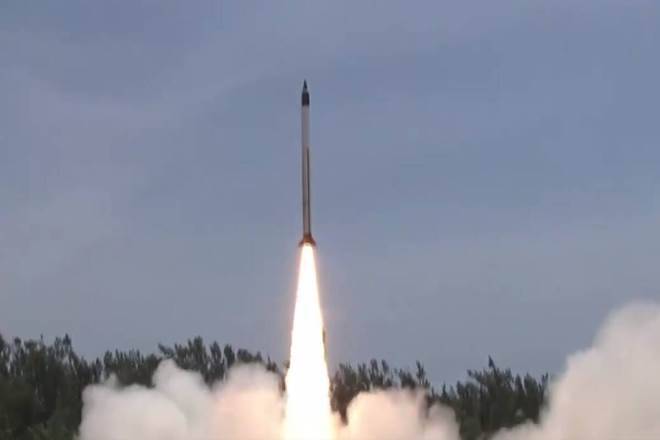
SOURCE: Daily Excelsior
On the 7th of September 2020, Indian scientists yet again reached another milestone when they successfully tested the Hypersonic sonic Technology Demonstrator vehicle (HSTDV) at 1100hrs from APJ Abdul Kalam launch complex Wheeler islands off coast of Odisha.
By this, India becomes only the fourth country after USA, Soviet Union (now Russia) and China to harbour the competence, capability and capacity to develop Hyper sonic glide vehicle for future war fare. This immense intricate superior technology working on the principle of hypersonic speed actually is a great boost to our defense arsenal thus capable of revolutionizing the future warfare.
By hypersonic, one means to attain the speed five times more than the speed of the sound. The speed of sound in air is around 343 meters per sec. This landmark achievement is yet another stepping stone towards a stronger India. Even the US Department of defence and intelligence also acknowledged this fact that the “Development in hypersonic purlins will certainly pave the way towards revolutionizing the future warfare by facilitating more quick striking of the targets even at greater distance with greater fire power.” By turning the pages of history, one finds that that speed in maneuverability has been of prime importance thus playing a key role in battle fields by providing edge against adversaries. This fact can well be ascertained by analyzing the time of the cold war, when both United States of Amercia and Soviet Union (now Russia) realized the importance of speed for future combats. So they initiated a number of programs for development of Hyper sonic vehicles which can be mounted on long range missiles. Besides, their forces also explored the possibility of using these vehicles in future wars against adversaries. They mainly focused on two types of vehicles. One Hypersonic Glide vehicles and another Hypersonic cruise missiles.
Hyper sonic glide vehicles are also called booster vehicles which employ booster rocket to carry them in outer space at altitude between 40 to 100 miles above the earth’s atmosphere after which they get separated. They also possess the ability to manoeuver flight using satellite guidance to strike the targets with greater precisions. Hypersonic cruise missile unlike Hypersonic Glide Vehicle fly with in atmosphere and can be launched from land ,ship and from air craft with speed greater than 5 Mach and above to destroy the major targets. The range of Hypersonic cruise missiles is less as compared to Hyper sonic glide vehicles. They have to be launched from the sight close to targets. China has developed Hypersonic glide vehicles and conducted number of tests to counter and thwart the threat from United States.
These Hypersonic vehicles are commonly known as DF-ZF and are in operation since October 2019. One of the key features is that these vehicles can be mounted on long range and short range ballistic missiles. Moreover, the analysts are of the view that Hyper sonic glider vehicle DF-ZF (named by NATO as WU-14) will be used in short range roles as an anti ship missile or for other tactical purposes to address the problem of moving targets with ballistic missiles. Moreover, the Chinese long term goal may be to include these as deterrence against the US missile capabilities with prospect strategic bombardment. Therefore Indian strategists and planners need to be well acquainted about this development in our neighborhood and acknowledge its repercussions. Especially when our northern neighbor has adopted wolf warrior diplomacy and is on a constant endeavor to alter status quo at LAC unilaterally.
Moreso, this has resulted into a very volatile situation at many points along LAC especially in eastern Ladakh where the situation is even more grim as troops from both sides are facing each other at eye ball distance. Parallelly our Western neighbor is bent upon creating trouble in Union territory of Jammu- Kashmir. Therefore successful testing of Hypersonic Technology Demonstrator Vehicle by India is a loud and clear message to our adversaries that India is fully capable to thwart any nefarious design of our neighbours. It is also a fact that India has attained self-reliance in missile technology.
Missile basically is a rocket propelled weapon designed to deliver with greater accuracy and high speed. Over the years India has produced innumerable types like air to surface, surface to surface, surface to air, and under water to air/surface missiles. Notably among them are Prithvi, Akash, Nag, Nirbhay, Agni series (A1, A2, A3, A4 and A5) and BrahMos cruise missile etc. Their range varies from few kilometer to more than 5000km.More over all sub systems including infrared seekers are indigenously developed. Many of these are nuclear capable.
Successful demonstration test of Hypersonic Technology demonstrator vehicle will further bolster their invisibility and striking power. DRDO scientists conducted this test by launching Hypersonic cruise vehicle using proven solid rocket motor. At an altitude of 30 km, the aerodynamic heat shield was separated at hypersonic Mach number. The cruise vehicle was separated from launch vehicle and the air intake opened as planned.
The hypersonic combustion sustained and Cruise vehicle continued on its desired path at the velocity six times the velocity of sound that is nearly 2km per sec for more than 20 seconds. The parameters of launch and cruise vehicle including scram jet engine were monitored by multiple tracking radars, electro optical systems and telemetric stations. A ship was also deployed at bay of Bengal to monitor the performance during cruise phase of Hypersonic vehicle.
All performance parameters Indicated resounding success of the mission. With successful demonstration, many critical technologies such as Aerodynamic configurations for Hypersonic manoeuver, use of scramjet engine propulsion for ignition and sustained combustion and thermo static characteristics of high temperature materials, separation mechanism at hypersonic velocities were proven. This successful test has definitely carved a niche for India in the Hypersonic technology arena but simultaneously will also enable it get hold of the most advanced Hypersonic Vehicle. Moreover, this is another feather in the cap while making India Atma Nirbhar in defence.






